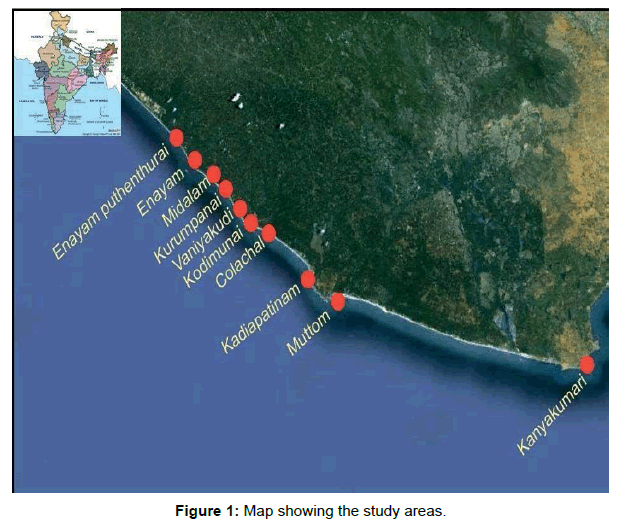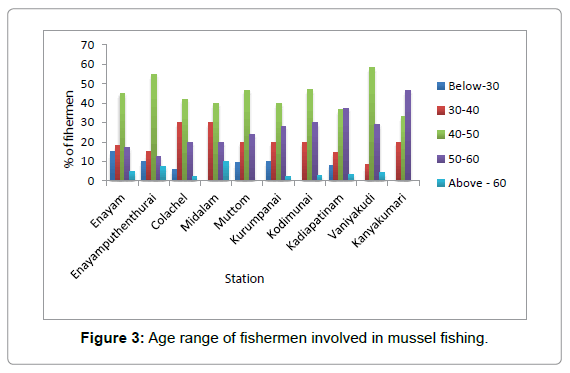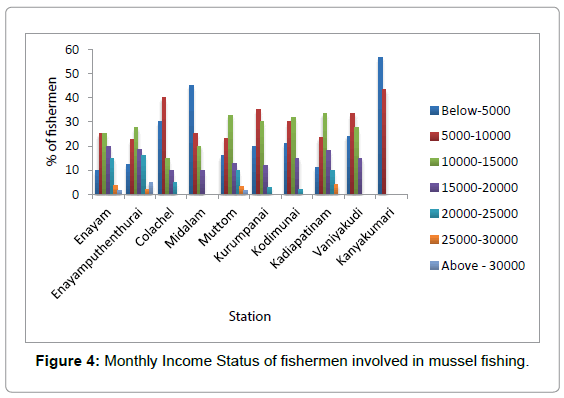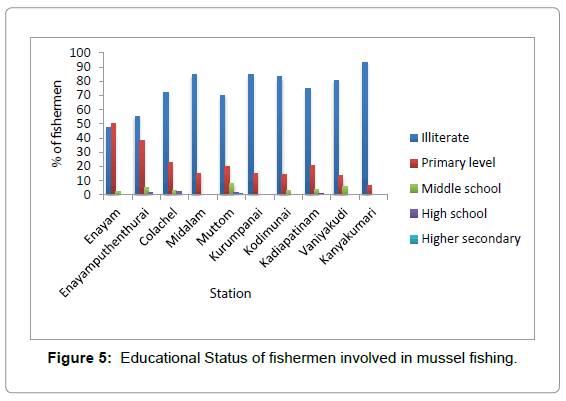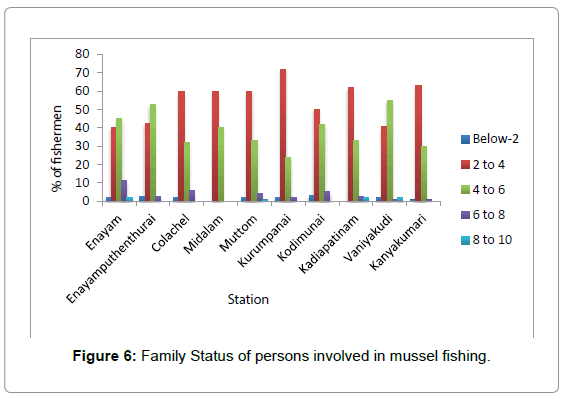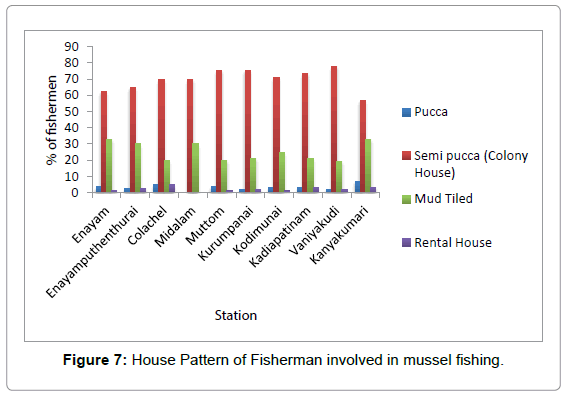Research Article Open Access
Socio Economic Status of Fisher Folks Engaged in Mussel Fishery at Kanyakumari District of Tamil Nadu, India
M. Dalin Mary1, Saritha Kailasam2*, M. Jansi3 and Jamila Patterson21St. Jude’s College, Thoothoor, Tamil Nadu, India
2Suganthi Devadason Marine Research Institute, Tuticorin, Tamil Nadu, India
3St. Hindu College, Nagercoil, Tamil Nadu, India
- *Corresponding Author:
- Saritha Kailasam
Suganthi Devadason Marine Research Institute
Tuticorin, Tamil Nadu, India
Tel: 914612336488
Fax: +914612325692;
E-mail: saritha23kailasam@gmail.com
Received date: July 22, 2015; Accepted date: August 07, 2015; Published date: August 13, 2015
Citation: Mary MD, Kailasam S, Jansi M, Patterson J (2015) Socio Economic Status of Fisher Folks Engaged in Mussel Fishery at Kanyakumari District of Tamil Nadu, India. J Marine Sci Res Dev 5:165. doi:10.4172/2155-9910.1000165
Copyright: © 2015 Mary MD, et al. This is an open-access article distributed under the terms of the Creative Commons Attribution License, which permits unrestricted use, distribution, and reproduction in any medium, provided the original author and source are credited.
Visit for more related articles at Journal of Marine Science: Research & Development
Abstract
This paper attempts to explore the extent of improvement due to mussel fishing in the ten sites of Kanyakumari district. As per our study the data on the percentage of fishermen involved in mussel fishery and their marital status, age status, income status, educational status, family status and housing pattern were collected through personal interview. Data regarding marital status show that 80.7% were married, 16.7% unmarried and 2.6% widower among fishermen involved in mussel fishery in Kanyakumari district. In case of age group, the fishermen involved in mussel fishery in Kanyakumari district revealed that 46% of them were in the age group of 40-50 followed by 50-60(24%) and 30-40(18%).The income status of the sample respondent varied and 55% of them earned Rs 5,000-15,000. Only 24% of them earn Rs 15,000-25,000 while other remains in other categories. In Kanyakumari district most of the fishermen (68.7%) involved in mussel fishery are illiterate and 26.6% are educated to primary level. Most of the fishermen involved in mussel fishery in Kanyakumari district have 2-6 members in their family (92.8%). When compared with four types of houses used by the fisher folks most of them (70%) were in semi pucca colony house. Based on our results it shows that the literacy level and awareness about education was very low around the fisherman. So it may b e suggested that more attention should be given to enhance the literacy level of the coastal population.
Keywords
Mussel fishery; Marital status; Age status; Income status; Educational status; Family status; Housing pattern
Introduction
Kanyakumari district is approximately having 68 km of coastal area with nearly 1 lakh fishermen involved in fishing. Kanyakumari coastal area covers about 26 percent of total fishermen of Tamil Nadu. Marine mussel fisheries are very important for the economy and well-being of coastal communities, providing food security, job opportunities, income and livelihood as well as traditional cultural identity. Maintaining the long term prosperity and sustainability of marine mussel fisheries is not only a political and social significance but also of economic and ecological importance. Details of the mussel fishery in Kanyakumari coast during the earlier years were given by Jones, Jones and Alagarswami, Appukuttan and Nair, Appukuttan et al. and Joel and Ebenezer [1-5]. Fishing is carried out throughout the year, except during the fishing holidays from first May to middle of June. The fisher folks are much aware about the different types of fishing, so they change the fishing according to the variation in the fishing season. Different forms of fishing like finfish and shellfish fishing were done in the kanyakumari coast. One group of fishermen knows skin diving and do mussel fishing in the rocky coastal areas during October to April. Present study was carried out to analyze the age groups, marital status, income status family status, educational status and housing pattern of the fishermen who are doing mussel fishing for their livelihood. Besides increasing fish production to the maximum, the fisheries development should aim at raising nutritional level of the people and improving the socio economic conditions of the fisherman. The socio economic condition of the marine fishermen and their attitude towards development schemes will serve as background information which is vital for implementing new technologies and politics.
Materials and Methods
Kanyakumari, district of Tamilnadu, forms the southern tip of India where the Bay of Bengal, Indian Ocean and Arabian Sea meet. Mussels are available plenty in rocky coastal areas of this district. Two species of mussels such as green mussel, P. viridis and the brown mussel P. indica are available more in the coastal areas of Enayamputhenthurai, Enayam, Midalam, Kurumpanai, Vaniyakudi, Kodimunai, Colachal, Kadiapatinam, Muttom and Kanyakumari (Figure 1). Among these two species P. indica is dominant in Kanyakumari coast which forms food for the coastal people. Mussel fishing is normally carried out as an off time occupation by the fishermen. They collect the mussels from intertidal rocks using iron scalpel with wooden handle during low tide. The craft and gears used for mussel fishing were observed and recorded from the fishermen. Socio-economic characteristics viz., marital status, age, monthly income, educational status, family status and Housing facility level were selected for the study. The data were collected from 1170 respondents through personal interview with the help of pretested survey schedule and the data were analyzed using the Excel XP 2007 software [6].
Results
Marital status
Marital Status of the fishermen involved in mussel fishing was analyzed and the result was presented in (Figure 2). The results revealed that in Enayamputhenthurai 90% of the mussel fishing fishermen are married and this was highest compared to the other coastal areas. The lowest percentage (70%) of married persons involved in mussel fishing was from Kurumpanai coastal area. In Kanyakumari coastal area 26% of fishermen involved in mussel fishing were unmarried, which was the highest when compared with other coastal areas. The lowest percentage of unmarried persons involved in mussel fishing was from Enayamputhenthurai (10%). The widower status of the persons involved in mussel fishing was analyzed during the study period in the ten coastal areas. It was found that in Colachel and Kurumpanai 6% of the fishermen involved in mussel fishing were widowers, compared to the other coastal areas. The lowest percentages of widower involved in mussel fishing were from Vaniyakudi (1.7%) coastal area. As a whole 80.7% were married, 16.7% unmarried and 2.6% widower among fishermen involved in mussel fishery in Kanyakumari district.
Age status
The status of the age group of the fishermen involved in mussel fishing was analyzed during the study period and the results were presented in (Figure 3). It was found that 15% of fishermen doing mussel fishery are below the age of 30 in Enayam, which was highest result when compared with the other coastal areas. In colachel coastal area 6% of these age group persons were involved in mussel fishing. In Colachel and Midalam coastal areas 30% of fishermen involved in mussel fishery were above 30-40 age group and this result was the highest compared to the other coastal areas and 8.3% of t persons of this age group were involved in mussel collection in Vaniyakudi .In Vaniyakudi coastal area 58.3% of fishermen in the age group of 40-50 were involved in mussel fishery and it was highest result compared to the other coastal areas. But in Kanyakumari costal area 33.3% of these age group fishermen were involved in mussel fishery. In this region 46.7% of fishermen engaged in mussel fishery were above the age group 50-60. Lower percentage (12.5%) of this age group persons involved in mussel fishery were observed in Enayamputhenthurai. In Midalam coastal area 10% of old men were involved in mussel fishing and only 2% of old men were involved in mussel fishing in Colachel and Kurumpanai coastal areas. As a whole the age status of the fishermen involved in mussel fishery in Kanyakumari district revealed that 46% of them were in the age group of 40-50 followed by 50-60 (24%) and 30-40(18%).
Income status
The income due to mussel fishing in different coastal areas was analyzed and results were presented in (Figure 4). The income status of the persons involved in mussel collection was analyzed during the study period 2010-2012 in all the ten coastal areas. It was found that in Kanyakumari 56.7% of persons involved in mussel fishing earns below Rs 5000 and 43.3% of person earns above Rs 5,000-10,000. The lower percentage of this income of Rs 5000-10000 was noted among the fishermen of Enayamputhenthurai (22.5%). In Kadiapatinam station 33.3% of the fishermen earn Rs 10, 000-15,000 by mussel fishing and this was the highest when compared with the other coastal areas and the lowest percentage (15%) was observed in Colachel. In Enayam, 20% of fishermen involved in mussel fishing earns above Rs. 15,000- 20,000 and this was the highest when compared with other coastal areas and the lowest percentages of this income was from the station Colachel and Midalam (10%). In station Enayamputhenthurai, 16% of persons involved in the collection of mussels were earning above Rs 20000-25,000 which was highest when compared with other stations and the lowest percentage of this income was observed from the station Kodimunai (2%). In station Kadiapatinam 4% of persons involved in the collection of mussels were earning above Rs 25,000-30,000, which was highest and the lowest percentage of this income status was with fishermen of Enayamputhenthurai (2.5%). The highest income status of Rs 30,000 and above were earned by fishermen of Enayam (5%) followed by Muttom and Enayamputhenthurai (1.5%) As a whole, in these ten sites, the income status of the sample respondent varied and 55% of them earned Rs 5000-15000. Only 24% of them earn Rs 15000- 25000 while other remains in other categories.
Educational status
The educational status due to mussel fishing in different coastal areas was analyzed and results were showed in (Figure 5). The Educational status of the persons involved in mussel collection were analyzed during the study period in the all the coastal areas. The percentage of the educational status of persons involved in mussel fishing varied between different stations. It was found that 93.3% of persons involved in the collection of mussels were illiterate in Kanyakumari which was the highest when compared to other coastal areas and 6.7% of persons were educated up to primary level. In station Enayam 50% of the fishermen involved in mussel fishing were with primary level education and 47.5% were illiterate. In Muttom 20% of persons involved in the mussel fishing were with educational status of primary level, 8% at middle school level, 1.3% at High school level and 0.7% at Higher Secondary level. In station Colachel only 2% of persons involved in mussel collection were educated to High school level, 3% to middle school level, 23% to primary level and the remains of 72% were illiterate. In Kanyakumari district most of the fishermen (68.7%) involved in mussel fishery are illiterate and 26.6% are educated to primary level.
Family status
The family status due to mussel fishing in different coastal areas was analyzed and results were represented in (Figure 6). The family status of the persons involved in mussel fishing was analyzed during the study period. It was found that in Kanyakumari, coastal region 3.3% of persons involved in mussel fishing coming under the family status of below 2 members. In Kurumpanai 72% of fishermen had 2-4 members in their family and this was the highest and the lowest percentage of 40% were observed in Enayam. In Vaniyakudi 55% of fishermen had 4-6 members in their families, and 24% of this size family was observed in Kurumpanai. In Enayam 11% of the families had 6-8 members where as 0.8% of families had this number of member’s in Vaniyakudi. In Enayam and Kadiapatinam (2%) of the fishermen family had 8-10 members in their families which was the highest followed by Vaniyakudi (1.7%) and Muttom (0.6%) Most of the fishermen involved in mussel fishery in Kanyakumari district have 2-6 members in their family (92.8%).
House pattern
The house types of fishermen involved in the mussel fishing at different coastal areas were analyzed and result was presented in (Figure 7). Housing type is one of the most important indicators of the economic status of the family. The mussel fishermen in Kanyakumari district lived in four types of house namely Pucca house, Semi-pucca house, Mud-tiled house and Rental house. It was observed from the above table that only 3% of fishermen have their own Pucca houses (i.e., a dwelling with tiled or concrete roof and brick wall) Most of the fishermen have their own semi-pucca houses (Government free colony houses) i.e., 70%. Nearly 25% of the fishermen were accompanied by mud-tiled house .It is apt to mention here that some of the fishermen don’t have their own house. Only 2% of the fishermen lived in rental houses. When compared with four types of houses, most of them (70%) were in semi pucca colony houses. So it could be informed that the economic status of the households of sample respondents of fishermen, as revealed by their housing conditions is poor even though most of the fishermen have their own house.
Discussion
Fisheries in India support the livelihood of about 10 million people. Fisheries development program are implemented to improve the socio economic status of the fishermen in terms of education, health, income and standard of living. In the present study, the analysis of the age status of fishermen involved in mussel fishing in Kanyakumari district revealed that 46.3% of fishermen are in the age group of 40-50, 24.1% of fishermen are in 50- 60 age group, 17.9% of fishermen are 30-40 age group, 7.9% of fishermen are below 30 age group and 3.8% of fishermen are above 60 age group, 70% of fishermen in the age range of 40-60 years were involved in mussel fishery. The family status of the person involved in mussel collection revealed that 52% of the fishermen family with 2-4 members, 41% of the family with 4-6 members, 4.4% of the family with 6-8 members and 2% of the family with below 2 members and 2% of the family with 8-10 members. The average family size in Poonthurai village near Thiruvananthapuram in 1985 was 6.3 and about 69% were living in huts [7]. The illiteracy rate was 46% and 89% of the literates had education up to primary level only. The educational status of person involved in mussel collection in Kanyakumari district revealed that the illiterate level of the mussel fishermen were higher (68.7%) than that of the fishermen at Poonthurai village [7] 26.6% are at primary level, 3.9% of them are at middle school level, 0.7% at high school level. During 1983, the economic condition of the fishermen in some selected villages of Maharashtra and Gujarat revealed that the illiteracy rate ranged from 48-75% and among the literates majority had primary education only [7] similar to the present observation. The present study reported that the income status of the person was increased as the mussel cost increased from Rs 90 to 120 for 100 mussels 35% of fishermen were coming under the income status of Rs 5,000- 10,000, 21% of the fishermen earn about were Rs 10,000-15,000 income 15% of the fishermen are below Rs 5000. Similarly 15% of the fishermen earn about Rs 15,000-20000 income, 10% of fishermen earn about 20,000- 25,000 income, 3% of the fishermen earn about Rs 25,000-30,000 and 1% of the fishermen were earning above Rs 30,000 per month. It was reported that the fishermen received an annual income between Rs 3000 and Rs 10000 in Puthiappa-puthiangadi area of calcutta during 1980 [7]. In this area the size of the fishermen family was large (9.0) as compared to non-fisherman family. Average family size in 1992 in Ernakulam district of Kerala was estimated to be 7.7, 5.5 and 5.6 for marginal small and large fish farmers respectively. The literacy level of the marginal farmers was less than high school qualification while 6% of the small farmers were graduates and post graduates. The housing pattern of the fishermen involved in mussel fishing in the Kanyakumari district revealed that most of them (70%) have their own semi-pucca houss (government free colony house) and 25% of them lived in mud tiled houses. Socio economic study of fishermen along the Madras coast showed that most of the fishermen (90%) in Thiruvettyurkuppam and 6% in Pudimanikuppam were lived in huts. The study conducted during 1989-90 to evaluate the socio economic condition of traditional fishermen living along the Tanjavur coast of Tamil Nadu indicated that most of fishermen were living in temporary structures like Kutcha house and Huts [7]. John Kurien [8] reported that most of the fishermen were living in huts (71.8%) at Poonthura village of Triuvandrum District.But in our study 70% of fishermen owned their own pucca houses.
Conclusion
Based on the studies conducted on the field of socioeconomics, it is suggested that more attention should be given to enhance the literacy level of the coastal population. Since the literacy rate is low, So small family norms should be popularized among the fishermen communities .because he bigger number of dependents creates poverty due to low economic status So from our study we suggest government should take necessary steps to improve the literacy rate, provide loan/ subsidies and create awareness about mussel processing techniques among the fisher communities to improve their economic status.
Acknowledgement
The authors are thankful to Dr. J.K. Patterson Edward, Director, Suganthi Devadason Marine Research Institute, Tuticorin, India for providing us the facilities to carry out the work.
References
- Jones S (1950) Observations on the bionomics and fishery of the brown mussel (Mytilussp.) of the Cape Comorin region of peninsular India. J Bombay Nat Hist Sac 49: 519-528.
- Jones S, Alagarswami K (1973) Mussel fishery resources of India. Proc. Symp.Living Resources of the Seas around India, Central Marine Fisheries Research Institute, Cochin 641-647.
- Appukuttan KK, Nair TP, Thomas KT (1989) Spat settlement of brown mussel PernaindicaKuriakose and Nair in the southwest coast of India. J marbiol Ass India 31: 266-275.
- Appukuttan KK, Nair TP, Mathew Joseph, Thomas KT (1988) Brown mussel (Pernaindica)resources of the southwest coast of India and the results of farming experiments at Vizhinjam. CMFRI Bull 42: 257-263.
- Joel JJ, Ebenezer IP (1989) The current trend of the mussel fishery in the Kanyakumari district of Tamil Nadu. Mar Fish Infer SeruT & E Ser 100: 9-13.
- Singh JY, Santhakumar R,Pandey DK, BharatiH, DebRoy P (2012) Adoption of Hygienic Fish Handling Practices by Fishermen. Indian Res J Ext Edu 12.
- Narayanakumar R, Panikkar KKP, Sekara DBS, Sathyadas R(2000) In: Marine Fisheries Research and Management (Menon, Pillai(Eds)) Socioeconomic analysis of marine fisherman in India, CMFRI publication, 60: 895-906.
- John kurien (1980) Fishermen’s cooperatives in Kerala-Acritique (BOBP/MISC/1, Bayof Bengal programme, Madras.)
Relevant Topics
- Algal Blooms
- Blue Carbon Sequestration
- Brackish Water
- Catfish
- Coral Bleaching
- Coral Reefs
- Deep Sea Fish
- Deep Sea Mining
- Ichthyoplankton
- Mangrove Ecosystem
- Marine Engineering
- Marine Fisheries
- Marine Mammal Research
- Marine Microbiome Analysis
- Marine Pollution
- Marine Reptiles
- Marine Science
- Ocean Currents
- Photoendosymbiosis
- Reef Biology
- Sea Food
- Sea Grass
- Sea Transportation
- Seaweed
Recommended Journals
Article Tools
Article Usage
- Total views: 18963
- [From(publication date):
December-2015 - Apr 02, 2025] - Breakdown by view type
- HTML page views : 14072
- PDF downloads : 4891

